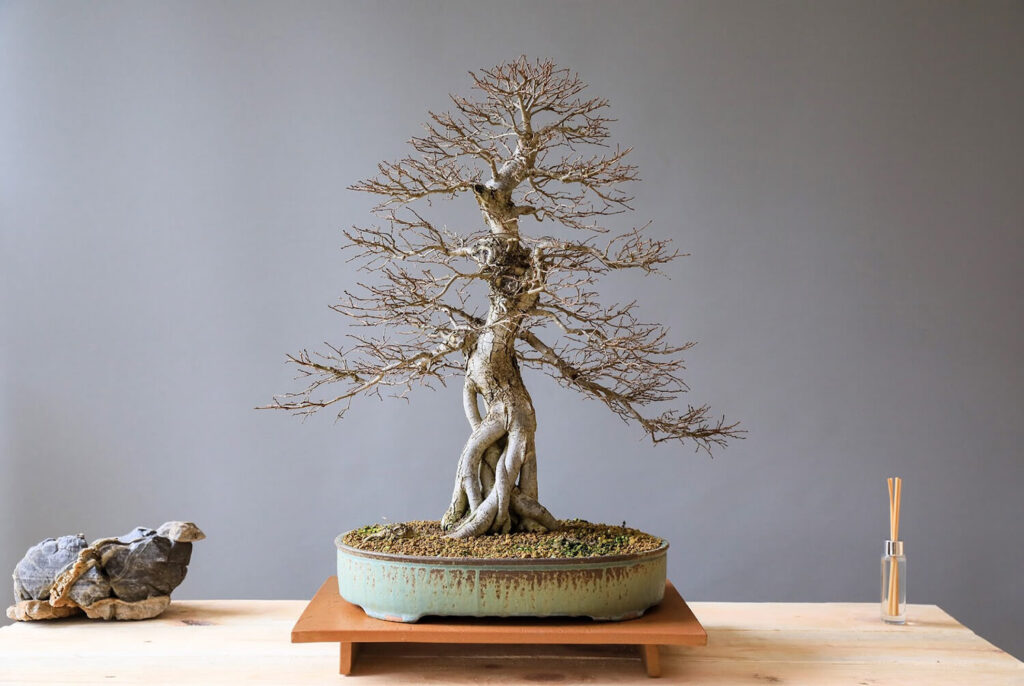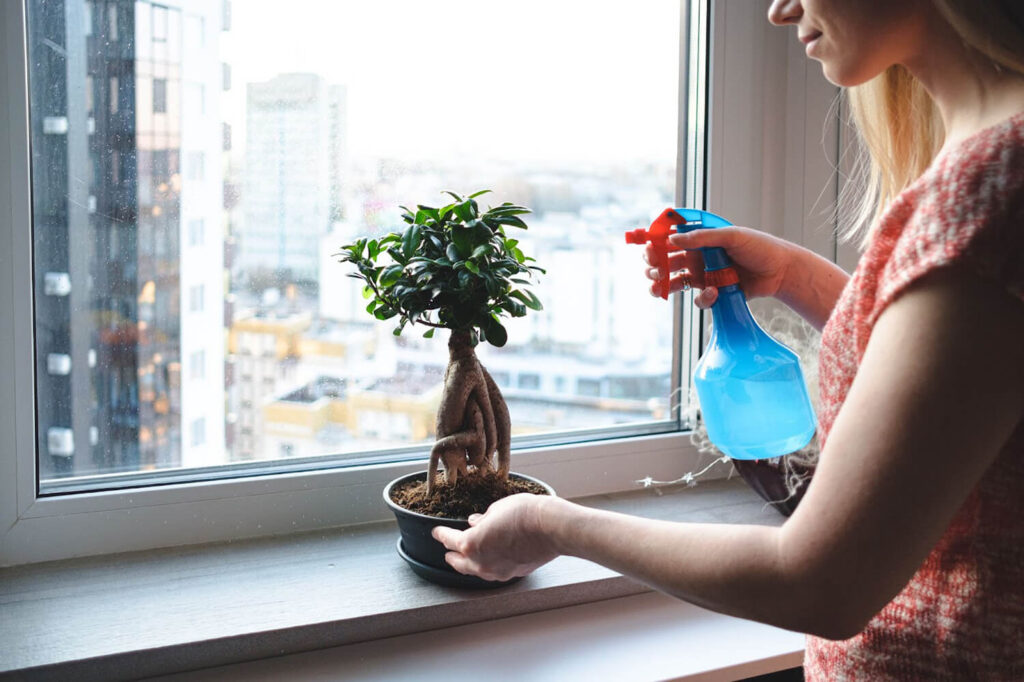Are the leaves on your bonsai tree falling off? Did the leaves suddenly drop out of season? If so, your bonsai may suffer from environmental stress due to improper care.
To know how to treat a shedding bonsai tree properly…
Continue reading to learn:
- Whether it’s normal for bonsai species to lose their leaves.
- How long it takes for a sick bonsai tree to regrow its foliage.
- 6 possible reasons why your bonsai tree leaves are falling off.
- 6 ways to treat a bonsai tree that’s shedding leaves out of season.
- And so much more…
Why Would Bonsai Trees Drop Their Leaves?
There would only be two reasons why a bonsai tree would drop its leaves; either it is:
- Preparing itself to enter its dormancy period
- Suffering from environmental stress due to improper care
Dropping leaves is common on some bonsai tree species, specifically deciduous ones. This type of tree naturally sheds its leaves in the fall or winter to store as much moisture as possible to utilize while it’s in its dormant state.
Here’s an example of a deciduous bonsai species that dropped its leaves in the fall:

If your bonsai isn’t a deciduous species, or it dropped or is dropping leaves out of season, your tree is sick. Examine your tree immediately to determine its cause. Then, apply the right treatment to your tree to save it from dying.
Bonsai Tree Leaves Falling Off: 6 Causes and Treatments
Before treating a sick bonsai plant, you must first identify what has caused the problem. That way, you can treat your tree properly and avoid causing further damage.
With that said, here are six possible causes why your bonsai tree leaves are falling off and how to treat them accordingly:
#1: Reacclimation
If your newly bought or newly repotted bonsai plant is losing leaves, this particular section is for you.
When a bonsai is moved to a new location, the tree slowly adapts to the new environment—this is called “re-acclimation.” One common thing they do is drop their old leaves near the trunk.
It’s very common and may happen within a few weeks of relocation.
Note: When moving an old bonsai to a new spot (perhaps moving indoor bonsai trees outdoors), do it gradually to minimize foliage loss—move it to a shaded location first for a few weeks.
This can also happen on newly repotted bonsai trees, especially those that have undergone root pruning, as this can be stressful to the tree.
How to treat it:
Give it some time to adjust and acclimate to its new location.
Then, ensure that your bonsai gets the right nourishment and nutrients by providing its basic needs, such as sufficient water, sunlight, and fertilizer.
With proper care, it can take a few weeks before new bonsai leaves appear on the branches.
#2: Wrong placement
Placing your bonsai in a bad spot can significantly affect its health. Depending on the species, too little or too much sunlight can cause your miniature tree to drop leaves abnormally.
Sunlight is crucial for potted plants to create their food. Hence, lack of light, especially for indoor plants, can slow down the tree’s growth progress, leading to it dying out.
How to treat it:
Determine whether your specific bonsai tree species is an indoor or outdoor bonsai.
If it’s an outdoor bonsai tree, placing it in a spot that receives morning sun and afternoon shade is highly recommended so your tree can receive sufficient sunlight without suffering from a leaf scorch.
Note: Many tropical and subtropical species can survive in temperate climates with proper care.
For indoor bonsai, such as Chinese elm or ficus bonsai, move it to a south-facing window where it can absorb more sunlight in a day. You can also use a plant grow light for extra support.
#3: Underwatering

For many bonsai enthusiasts, a common concern is ‘bonsai tree leaves falling off.’ This can be particularly alarming for beginners.
Underwatering is one of the most common causes of bonsai dropping leaves abnormally, especially for beginner bonsai lovers.
Insufficient water, or lack of it, causes the soil to dry up and the plant’s roots to die. Once this happens, other parts of the plant will start to deteriorate, including the leaves—that’s when the bonsai leaves start to fall off within days.
Note: Usually, the bonsai leaves turn brown or yellow before they drop. Also, this can affect both old and new leaves.
This often happens during hotter periods when the weather is too hot and the dwarf trees’ water intake increases.
Compared to outdoor bonsai trees, indoor bonsai plants are more prone to underwatering as they dry up quickly due to low humidity and installed cooling or heating systems inside the house.
How to treat it:
The only way to treat underwater bonsai trees is to keep them well-moisturized daily.
If the soil of your bonsai is completely dried up, dunk its whole pot into a bucket of water for a few seconds to wet its soil. If the tree is too heavy to lift, water it normally using a watering can or hose until the water runs out of the pot’s drainage holes.
Tip: Adding moss at the top layer of the soil or using moisture-retaining substrates on your bonsai soil mix can help retain more moisture.
More importantly, don’t water your bonsai on schedule. Water it as soon as you notice its soil starts drying up.
#4: Overwatering
Bonsai drop leaves as well when they become overwatered.
Once the soil stays too wet for too long, the tree’s root system may suffer from waterlogging, which causes root rot after a certain time. When this happens, the tree will weaken and drop leaves.
However, unlike underwatered miniature trees, the signs of overwatering can take a while to show up, which makes it quite harder to detect. Bonsai leaves turning brown or drooping is one common sign of it.
One important thing you should know is that: the major cause of overwatering is poor-quality soil and poor drainage.
How to treat it:
Every experienced bonsai enthusiast would suggest that you water your bonsai only once the soil becomes slightly dry. That way, you can keep your tree nourished without overwatering it.
Aside from that, you should use a well-draining soil blend and bonsai pot with proper drainage to drain excess water and prevent waterlogging.
#5: Under-fertilizing or over-fertilizing
If you see your bonsai leaves turning yellow or dull before they drop, it may indicate that your bonsai is under-fertilized or over-fertilized. Whichever it is, it can cause your tree to lose strength and drop leaves out of season.
Whether it’s an indoor bonsai or outdoor bonsai, a lack of nutrients and lack of sunlight is a recipe for a weak and disease-prone tree.
The same goes for overfeeding. Too much fertilization can lead to damaged roots due to root burn.
How to treat it:
Bonsai require feeding roughly twice a month or longer during the growing season, depending on the product you’re using. Make sure to follow the measurements indicated on the product packaging to avoid under or over-fertilizing.
Note: Fertilization isn’t needed in winter as dormant trees can barely absorb nutrients during these times.
Many bonsai species can take an organic fertilizer or synthetic fertilizer with problems as long as it’s applied correctly.
To avoid root burn, use slow-release pellet fertilizers. You can also partner it with a liquid fertilizer to promote faster and better growth.
#6: Pest infestation or disease infection

Both indoor and outdoor bonsai can suffer from pest infestation or disease if not cared for properly, leading to issues such as ‘bonsai tree leaves falling off.‘
Some of the most common pests on bonsai include:
- Aphids
- Vine weevil
- Spider mites
- Scale insects
Here are also some of the most common diseases:
- Fungal rust
- Black spots
- Sooty mold
- Powdery mildew
When infested or infected, trees lose their vigor and decline in health. It can lead to bonsai dropping leaves abnormally, root, rot, or dieback.
How to treat it:
If you can eliminate the pests on the leaves and branches by manually removing them by hand, do so. However, the most effective way to get rid of them is to use insecticides and pesticides made specifically for such pests and diseases.
It would be best if you also cut off the affected areas to avoid further infestation on your tree. Also, clean and sterilize your bonsai tools to prevent the diseases from transferring to your other potted plants.
Suppose its soil is infested with pests; repot your bonsai in the next growing season using fresh bonsai soil. If the damage is severe, you may repot immediately, but you must protect your tree from environmental stress.
Watch this video to learn how to properly and safely repot your bonsai trees out of season:
Will the Leaves on My Bonsai Tree Grow Back?
Various things can affect the recovery of your bonsai plant, including the following:
- Extent of damage
- Environment situation (e.g., climate, temperature)
- Treatment provided and how quickly it was treated
- The state of the tree (how much of its parts are alive)
- Tree species (whether it can grow new buds on bare areas)
Among these things, the first thing you should check on is the state of the tree. Determine whether your tree is still alive or already dead by checking its cambium layer—it’s a thin growing layer in the trunks, branches, and roots.
You can access the cambium layer by creating a small scar on the area you want to test. If you see a green layer, your tree is still alive—at least on that specific part. If that’s the case, your bonsai plant is salvageable as long as you provide it with proper care.
Trees that are completely dried up or severely infected by diseases can be difficult to cure.
Note: It can take several weeks until you see progress on your bonsai tree. Some species even take until the next growing season to show signs of recovery.
Conclusion
Like other plants, a bonsai is a living miniature artistic plant that reflects its health through its appearance.
If it’s weak or ill, the drooping and falling of bonsai tree leaves out of season is totally expected. When this happens, examine your tree thoroughly to determine the cause. Doing so allows you to find and provide the right treatment for your tree.
Aside from providing the right treatment, how quickly you respond to your tree’s needs would also impact its recovery. That said, treat your bonsai immediately as soon as you notice it losing its leaves.
However, if you want to avoid all these hassles, keep your bonsai in its best shape by providing it with proper care, nourishment, and nutrients throughout its life.





0 Comments